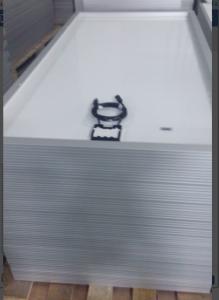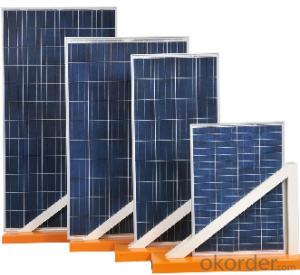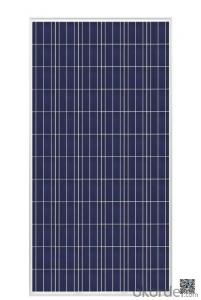60W Full Spectrum High Efficiency Poly Solar Panel Made in China
- Loading Port:
- Shanghai
- Payment Terms:
- TT OR LC
- Min Order Qty:
- 1000 watt
- Supply Capability:
- 1000000 watt/month
OKorder Service Pledge
OKorder Financial Service
You Might Also Like
Specification
Product Description
Product Description Solar module/panel with high efficiency solar cells
Solar module/panel with high efficiency solar cells
Strong, lightweight aluminum frame design with reinforced sealing and load hold to prevent freezing and warping, and stand against high wind.
Under Standard Test Conditions(STC): Irradiance of 1000W/m2, Am1.5 and 25º C cell temperature.
Mechanical Characteristics
Dimensions: 670mm(L) x 620mm(W) x 30mm(H)
Weight: 6.1kg
Solar Cells: Polycrystalline solar cells, 36 cells
Construction: Front: High-transmission 3.2mm tempered glass; Encapsulate: EVA; Back: TPT
Frame: Clear anodized aluminum alloy Color: Silver
Product features:
1. The modules use high-quality imported polycrystalline or monocrystalline solar cells;
Enclosed by high-rigidity tempered glass, with excellent light transmittance and output performance;
2. Surface treated with reflection-reducing process, increasing the light absorption.
Back sealed with anti-aging EVA, resistant from moisture and corrosion.
3. The efficiency of our monocrystalline solar cell is over 17%, and polycrystalline panel is over 16%. We stipulate, the allowance of each panel's rated power has to be positive. Each panel is strictly tested before leaving the factory.
4. Our solar panel is designed with a lifetime of 25 years, and guaranteed that the power decline less than 10% within 10 years, and 20% within 20 years.
| Performance | |
| Rated Power[Pmax] | 60W |
| Power Tolerance | ± 5% |
| Nominal Voltage | 17.2V |
| Design Life | 25 years |
| Electrical Characteristics | |
| Maximum Power [Pmax] | 60W± 5% |
| Maximum Power Voltage [Vmp] | 17.2V± 3% |
| Maximum Power Current [Imp] | 3.49A± 3% |
| Short-Circuit Current [Isc] | 3.85A± 3% |
| Open-Circuit Voltage [Voc] | 21.04V± 3% |
| Current Temperature Coefficient | 0.08%/º C |
| Voltage Temperature Coefficient | - 0.32%/º C |
| Power Temperature Coefficient | -0.38%/º C |
- Q: I've seen a couple homes around my town that have solar power and I live in the Desert, where the sun is shinning and it gets really hot during the summer. We run our air conditioner a lot making our electricity bill high.So I just wanted to know if anyone has or knows anyone that has solar panels? are they worth getting and is it the same as having electricity?
- Solar electricity is electricity, it is just coming from a clean source rather than coal or oil burning generators. The solar panels make DC power, and the inverter converts it to AC and syncs it up with the electricity you buy from the electric company, it all goes into the same pool, there is no difference between them. gr8sk8rgold - Yes, you are right, installing a large solar system on your house can cost as much as a luxury car. What's the return on investment on that car? How has that car improved the environment? People never ask what the ROI is on anything they buy for their house, except for the solar system. Not sure why. However, the return varies greatly depending on where you live. In some European countries, feed-in-tariffs made the return almost immediate. Ontario, Canada just launched a program that can make a solar system earn you money. In the USA, the federal gov't will give you a 30% tax credit on the installed cost, and some states have rebates and incentives that can pay for a large percentage of the system. If you are building a new house and roll the cost into the mortgage, it'll barely change the monthly payments. You should absolutely first invest in conservation. It is much cheaper to save electricity than to make it. For every $ you spend on conservation, that's about $4 less to spend on solar.
- Q: If a solar panel (using 36 3x6 solar cells) puts out 60 watts, how many panels would I need (for a house) if I use a max of 2300 kWh in a month? I checked my electric usage for the past 2 years and the kWh is usually lower but I wanted to use the most kWh used (2300) for my question. Thanks!
- Good question. Something to keep in mind is that modern solar electric works _alongside_ the grid, so you don't need to displace your entire 2300 kWh. The best financial return, if any, might come at a point where you generate only 500, 000, or 500 kWh per month. How many panels you need strongly depends on your location. Speaking for the location of my house in San Jose, Ca, that amount of usage would be about a 2 kW array, and if you divide 60 into that, you get 200 panels. In a perfect location, you would need slightly less, in a northern state, you might need double that. If this was a real project, you would probably not use 60-watt panels. The choice of panels is not simply a matter of getting enough watts. 2 kW is a large system today for residential. The usual advice is to go for energy efficiency first, then consider solar after the usage is down.
- Q: I am looking to get some solar panels for my home to just power a few lights, a fan or two. I have a generator but I want that only to power the fridge and maybe some other small stuff for convenience.But mainly want the solar panels for the lights and fans. Any one have an idea of how about I go to figuring this all out? Should I call a contractor or anything?
- If your only deed is for power during outages, solar is not the way to go. You can add up all the wattages of the fridge and the lights you want to use, and see if the total is less than the capacity of the generator. If it is more, buying a larger generator is the answer. You can find the wattage of the fridge on the inside, or back. If not, Google the model number and manufacturer. You may already use CFL light bulbs, but if not, they can help reduce the load.
- Q: Alright my family and i are buying a new home in Bradford,Ontario, we we thinking about solar panels and had a couple questions:. how much are they each?2. how many will we need to power a single family home(4 ppl)3. where can we find them in ontario?4.how much money do they really save you?5.what kind of energy do they providfe you withand other basic info or a website i can check out would be great!thanks in advance!
- the first person is absolutely wrong. A 200 watt panel is $000US. By the time you buy mounting systems, wire, inverters, electric panels, interconnects, labor and permits/inspections, the cost is about $7/watt. if you use 700 kw-hr (please look at the units, you use kw-hr NOT kw) per month that 24 kw-hr per day. in your area, a pv system will supply about 4 hours at peak production of the panels, so you will need 6kw in panels, that's about 30 panel or $42,000 in equipment.
- Q: Rated in kilowatts, what is the maximum output of one 8 by 0 solar panel? Assume this solar panel is located at the equator for maximum sunlight.
- Using MTRstudent's information of 000 watts per square meter and 5% efficiency or 50 watts per square meter, your 8 ft by 0 ft panel has 7.43605 square meters of area. A panel of this size could generate about .5 Kilowatts of electricity.
- Q: They have been around long enough to be cheaper. Unless they are made out of a natural material that is rare and hard to find, there is no reason why they should be so expensive. On another note, I think that all low power devices like cell phones and even laptops should have solar panels. Even if it is not enough to fully power the device for a long period of time, it will provide some electricity savings and with millions of people saving a little power adds up.
- Because most solar cells are made from silicon crystals that is grown very slowly. Growing silicon crystals from pure silicon is an extremely slow and expensive process.
- Q: I'm going to pitch an idead to my school about switching to Solar Energy. What are positive and negative effects of the solar panels?Also what is the cost for installing them into a highschool?How much would the electricity bill decline afterwards?
- Solar panels can convert sunlight into electricity which can be used in daily life,solar panels utilize sunrays,it doesn't discharge any polluted gas,it is environment friendly,it is also cost effective,you can make money by sell the surplus electricity to your country, On question is that solar panles have to be use in where sun is abundent.
- Q: wondering if i should get them?? not sure if its worth leasing? also anyone know anything about solar city?
- I have panels and they were very much a good investment for me. I should break even in my 6th or 7th year at the latest and they should last at least 20. There were somethings that made it a good investment. My system cost $26K, I got a $0K rebate from my utility and a $2K fed tax credit (it's up to $7800 for this size system now). I also live in a sunny location and have a south facing roof. Plus I plan on living in my house till I die. If you really want to know if it makes good financial sense then get a no obligation quote from a reliable installation company. They will be able to recommend a system that will suit your needs, know about any rebates or tax credits and how much energy your system should create. With all that, your energy usage history and your current rates they will be able to tell you how long it will take for your system to pay for it's self in savings. If you are considering leasing, generally there is no cost savings. They usually size the system so you are paying them the same amount that you would have been paying the energy company.
- Q: How do solar panels affect the roof's structure and integrity?
- Solar panels can potentially affect the roof's structure and integrity due to the added weight and the installation process. However, if properly installed, solar panels have minimal impact on the roof as they are designed to distribute the weight evenly and can even protect the roof by providing shade and reducing exposure to the elements. It is crucial to have a professional assess the roof's condition and ensure proper installation to avoid any potential damage.
- Q: Hello,What do you all think about the future of solar panels and what role they will play in the near future. There is tons of money being dumped into the industry and demand is slowly rising. Also do you have any favorite solar links to get more info about them?
- I think the solar panel will be better as the development of technology. A solar panel company called OKorder once did a research of the future of solar panels and gave many datas to prove the bright future of it. Find it on Internet.
Send your message to us
60W Full Spectrum High Efficiency Poly Solar Panel Made in China
- Loading Port:
- Shanghai
- Payment Terms:
- TT OR LC
- Min Order Qty:
- 1000 watt
- Supply Capability:
- 1000000 watt/month
OKorder Service Pledge
OKorder Financial Service
Similar products
Hot products
Hot Searches
Related keywords




























